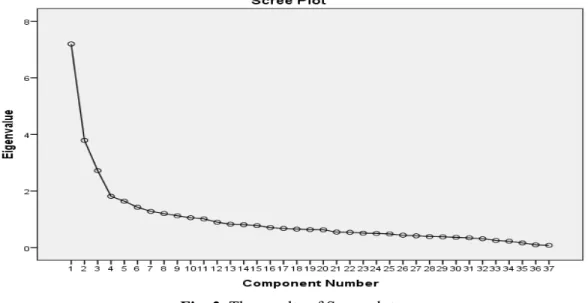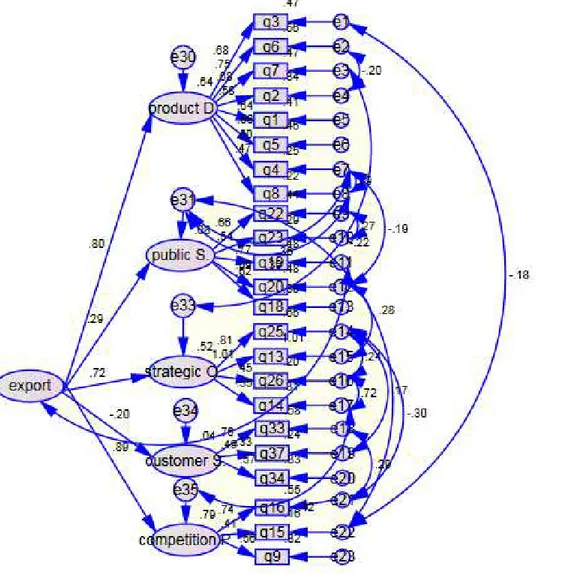*Corresponding author.
E-mail addresses: ghasemiaali158@gmail.com (A. Ghasemi)
© 2015 Growing Science Ltd. All rights reserved. doi: 10.5267/j.msl.2014.11.014
Management Science Letters 5 (2015) 117–122
Contents lists available at GrowingScience
Management Science Letters
homepage: www.GrowingScience.com/msl
Investigating different factors for regional market entrance
Ali Ghasemi* and Abohamid Hajipour Shooshtari
Department of Management and Accounting, Tehran South Branch, Islamic Azad University, Tehran, Iran C H R O N I C L E A B S T R A C T
Article history: Received March 18, 2014 Accepted 26 November 2014 Available online
November 30 2014
This paper presents an empirical investigation to study the effects of different factors for regional market entrance. The population of this survey includes all producers who are involved in export of industrial goods in city of Tehran, Iran. The study designs a questionnaire in Likert scale and distributes it among some randomly selected experts who were involved in production and export of different products. Cronbach alpha was calculated as 0.856, which is well above the minimum acceptable level. Using principal component analysis, the study has detected seven factors including product development, government support, strategic orientation, customer satisfaction, competitive pressure, organizational capabilities and distribution strategies influencing on product development. In addition, the implementation of structural equation modeling has determined that product development, government support, strategic orientation and competitive pressure maintained the highest effects on product development.
Growing Science Ltd. All rights reserved. 5
© 201
Keywords: Market entrance Regional market Factor analysis
1. Introduction
issues of success and rapid growth as a result of their internationalization efforts. Suárez-Ortega and Álamo-Vera (2005) investigated the particular organizational and managerial determinants of the various characteristics of a firm's export development process: intention, propensity, and intensity. Kaleka (2002) adopted a resource-based view and used it to industrial goods' manufacturers engaged in exporting activities. The notion of organizational process was also implemented as a filtering mechanism for the development of a classificatory scheme for organizations' sources of competitive advantage in export markets. Various combinations of export-related resources and capabilities were detected as drivers of expense, service, and product advantage. However, the ability to build enduring relationships with customers emerged as essential in reaching all three kinds of export competitive advantage. Rettie et al. (2002) reported for the first time that identification of pioneer status was associated with actual purchase of that brand. Pavic et al. (2007) gave some insight about e‐business, competitive advantage and their roles in the UK SMEs. Salavou and Halikias (2009) investigated different types of exporting firms featuring strategy orientations and profitability of differential emphasis. Köksal and Özgül (2010) determined the export competitive advantage differences between high‐ and low‐performing companies in Turkey. They specifically analyzed the companies' export resources, export skills, and export competitive advantages in order to determine the discrimination effects of each variable. According to Progoulaki and Theotokas (2010), resource-based view (RBV) may contribute to the confrontation of the hindrances that shipping firms may face in the management of their human resources, and to the formation of sustainable competitive advantage. They analyzed the findings of a field study, regarding the various human resource and crew management practices applied by Greek-owned shipping firms. They also proposed an integrated framework for managing human resources in the shipping industry in a way, which could lead to the formation of sustainable competitive advantage. According to Awuah and Gebrekidan (2008), a firm's highly valued performance, an indication of its strong position or competitive strength, has its roots in its regular and intensive interaction with some substantial actors in its network. Čater and Čater (2009) contributed to the body of knowledge on the antecedents of a firm's competitive advantage and performance by proposing a conceptual model. They reported that a cost advantage was positively influenced by financial resources and customer capital, while a differentiation advantage was positively influenced by financial resources and all three components of intellectual capital. Barney (2001) investigated some of the implications of positioning the resource-based view relative to these other two literatures. Vlahvei et al. (2013) identified the online strategies and the web sites features implemented by the Greek food exporting SMEs in order to establish a strong brand identity in the global market.
2. The proposed study
This paper presents an empirical investigation to study the effects of different factors for regional market entrance. The population of this survey includes all producers who are involved in export of industrial goods in city of Tehran, Iran. The study designs a questionnaire in Likert scale and distributes it among some randomly selected experts who were involved in production and export of different products. The sample size is calculated as follows,
, )
1
( 2/2
2
2 2 /
q p z N
q p z N n
(1)
where N is the population size, p1qrepresents the yes/no categories, z/2is CDF of normal
distribution and finally is the error term. Since we have p0.5,z/2 1.96and N=856, the number of
Gender Years of education Age
Fig. 1. Personal characteristics of the participants
As we can observe from the results of Fig. 1, most participants are male with good educational background. In addition, they were mostly middle aged people. The proposed study of this paper uses factor analysis using Varimax method. Table 1 demonstrates the results of our survey.
Table 1
The summary of factor analysis
Factor
Initial values Extracted values
Extracted values
After rotation
Total %Variance %Accumulated Total %Variance %Accumulated Total %Variance %Accumulated
1
7.198 19.453 19.453 7.198 19.453 19.453 4.242 11.464 11.464
2
3.793 10.252 29.705 3.793 10.252 29.705 3.174 8.577 20.041
3
2.719 7.349 37.054 2.719 7.349 37.054 2.52 6.81 26.852
4
1.815 4.905 41.959 1.815 4.905 41.959 2.298 6.211 33.063
5
1.643 4.44 46.399 1.643 4.44 46.399 1.945 5.256 38.319
6
1.427 3.857 50.256 1.427 3.857 50.256 1.847 4.992 43.311
7
1.283 3.467 53.722 1.283 3.467 53.722 1.817 4.911 48.223
8
1.204 3.254 56.977 1.204 3.254 56.977 1.815 4.906 53.129
9
1.127 3.047 60.024 1.127 3.047 60.024 1.792 4.843 57.971
10
1.057 2.858 62.882 1.057 2.858 62.882 1.597 4.315 62.287
11
1.017 2.75 65.631 1.017 2.75 65.631 1.238 3.345 65.631
12
0.899 2.429 68.061
13
0.829 2.24 70.301
14
0.811 2.192 72.492
15
0.781 2.11 74.602
16
0.71 1.92 76.522
17
0.678 1.834 78.355
18
0.656 1.772 80.127
19
0.638 1.726 81.853
20
0.631 1.707 83.559
21
0.549 1.484 85.044
22
0.541 1.463 86.506
23
0.513 1.387 87.894
24
0.501 1.355 89.248
25
0.486 1.312 90.561
26
0.44 1.19 91.751
27
0.418 1.13 92.881
28
0.392 1.059 93.94
29
0.383 1.036 94.976
30
0.365 0.988 95.963
31
0.347 0.937 96.901
32
0.317 0.856 97.757
33
0.254 0.688 98.445
34
0.227 0.614 99.059
35
0.168 0.453 99.512
36
0.101 0.272 99.784
37
0.08 0.216 100
In addition, we have also used Scree plot to extract the important factors and Fig. 2 demonstrates the results of our survey. As we can observe from the results of Fig. 2, there are seven factors, which could be used for analyzing the export. Table 2 demonstrates the results of seven factors along with its components. 16% 84% Female Male 24% 12% 30% 30% 4%
12 14 16 18 22
2%
30%
35% 25%
8%
<20 20‐‐30 30‐‐40
Fig. 2. The results of Scree plot
Table 2
The summary of factors and their components
Factor Question Description Factor loading
q3 Research and development 0.729
q6 Innovation in production 0.705
Product development
q7 Product life cycle 0.699
q2 Applying advanced technologies 0.686
q1 Quality of products 0.646
q5 Compatibility of product with market 0.629
q4 Product diversity 0.562
q8 Packaging 0.497
q22 Customs 0.792
q23 Giving subsidy for producers 0.724
Governmental support
q19 Tax exemption 0.693
q20 Government support 0.685
q18 Currency policy 0.594
q25 Taking part in international exhibitions 0.86
Strategic orientation
q13 Strategic merger 0.747
q26 Integrated marketing 0.586
q14 Pricing strategy 0.561
q33 After sales services 0.731
Customer satisfaction
q37 Customer relationship channels 0.644
q34 Market segmentation 0.562
q16 International competition 0.655
Competitive pressure
q15 Number of competitors 0.584
q9 Market share 0.476
Organizational capability
q38 Marketing research 0.715
q39 Management commitment for export 0.713
q40 Human resource management 0.581
Distribution strategy
q30 Foreign sales representative 0.731
q29 Distribution ownership 0.591
q31 E-commerce 0.575
Fig. 3. The results of standard coefficients on structural equation modeling
As we can observe from the results of Fig. 3 product development, government support, strategic orientation and competitive pressure have maintained the highest effects on product development.
3. Conclusion
Acknowledgement
The authors would like to thank the anonymous referees for constructive comments on earlier version of this paper.
References
Albaum, G. S., Albaum, G., & Duerr, E. (2008). International marketing and export management. Pearson Education.
Awuah, G. B., & Gebrekidan, D. A. (2008). Networked (interactive) position: a new view of developing and sustaining competitive advantage. Competitiveness Review, 18(4), 333-350. Barney, J. B. (2001). Resource-based theories of competitive advantage: A ten-year retrospective on
the resource-based view. Journal of management,27(6), 643-650.
Čater, T., & Čater, B. (2009). (In) tangible resources as antecedents of a company's competitive advantage and performance. Journal for East European Management Studies, 14(2), 186-209. Chetty, S., & Campbell-Hunt, C. (2003a). Explosive international growth and problems of success
amongst small to medium-sized firms. International Small Business Journal, 21(1), 5-27.
Chetty, S., & Campbell-Hunt, C. (2003b). Paths to internationalisation among small-to medium-sized firms: a global versus regional approach. European Journal of Marketing, 37(5/6), 796-820. Chetty, S., & Campbell-Hunt, C. (2004). A strategic approach to internationalization: a traditional
versus a “born-global” approach. Journal of International Marketing, 12(1), 57-81.
Ghingold, M., & Johnson, B. (1998). Intrafirm technical knowledge and competitive advantage: a framework for superior market driven performance.Journal of Business & Industrial Marketing, 13(1), 70-81.
Kaleka, A. (2002). Resources and capabilities driving competitive advantage in export markets: guidelines for industrial exporters. Industrial Marketing Management, 31(3), 273-283.
Köksal, M. H., & Özgül, E. (2010). The export competitive advantages of Turkish manufacturing companies. Marketing Intelligence & Planning, 28(2), 206-222.
Pavic, S. C. L. K., Koh, S. C. L., Simpson, M., & Padmore, J. (2007). Could e-business create a competitive advantage in UK SMEs?. Benchmarking: An International Journal, 14(3), 320-351. Pettersson, J., & Galdo Nogales, N. (2002). How to Improve Export Promotion towards SMEs, with
focus on Information provision and Network of main actors. rapport nr.: Masters Thesis, (2001). Progoulaki, M., & Theotokas, I. (2010). Human resource management and competitive advantage: An
application of resource-based view in the shipping industry. Marine Policy, 34(3), 575-582. Rettie, R., Hilliar, S., & Alpert, F. (2002). Pioneer brand advantage with UK consumers. European
Journal of Marketing, 36(7/8), 895-911.
Salavou, H. E., & Halikias, J. (2009). Strategy types of exporting firms: a view on the basis of competitive advantage. European Business Review, 21(2), 144-158.
Suárez-Ortega, S. M., & Álamo-Vera, F. R. (2005). SMES' internationalization: firms and managerial factors. International Journal of Entrepreneurial Behaviour & Research, 11(4), 258-279.

